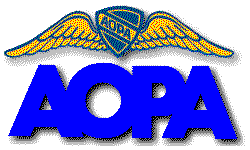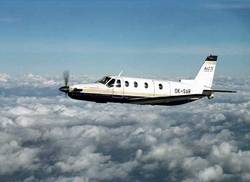Boyer Tells TSA Airspace "Pain" Goes Far Beyond DC and NYC
 With the
major fighting in Iraq now over and the terror threat level in the
United States lowered from Orange to Yellow, the AOPA is once again
pushing federal authorities to lift longstanding "temporary" flight
restrictions (TFRs). While the New York Air Defense Identification
Zone (ADIZ) and the downtown Chicago TFR have been rescinded,
flight restrictions still plague pilots in 13 states, from the
state of Washington to the District of Columbia.
With the
major fighting in Iraq now over and the terror threat level in the
United States lowered from Orange to Yellow, the AOPA is once again
pushing federal authorities to lift longstanding "temporary" flight
restrictions (TFRs). While the New York Air Defense Identification
Zone (ADIZ) and the downtown Chicago TFR have been rescinded,
flight restrictions still plague pilots in 13 states, from the
state of Washington to the District of Columbia.
Isn't It About Time?
In a letter to TSA chief James Loy, AOPA President Phil Boyer
said, "AOPA members are asking, 'Isn't it time for temporary
restrictions to be lifted given the reduced threat level, ending of
hostilities in Iraq, and phase-out of Operation Liberty
Shield?'"
 AOPA
recently conducted a review of the 16 national security TFRs that
have been in effect since shortly after the September 11 terrorist
attacks, and every area has a local impact on general aviation
operations.
AOPA
recently conducted a review of the 16 national security TFRs that
have been in effect since shortly after the September 11 terrorist
attacks, and every area has a local impact on general aviation
operations.
For example, four security TFRs in Washington State's Puget
Sound region have had a significant impact on three Victor airways,
VFR arrivals and departures at three airports, and have led to the
closure of a seaplane base. Similar impacts have been felt in
Arkansas, Indiana, Kentucky, Hawaii, Texas, Colorado, Alabama,
Utah, Missouri, and Georgia.
"AOPA is asking the TSA to consider removing these
restrictions," said Boyer. "We want to ensure due consideration is
given to the continued need for each one, especially when you
consider that these restrictions have been in place for almost 18
months."
The Letter
April 25, 2003
James Loy, Administrator
Transportation Security Administration
11th Floor, TSA-9
400 Seventh Street, SW
Washington, DC 20591
Dear Admiral Loy,
The Aircraft Owners and Pilots Association (AOPA), representing
the interests of almost 400,000 general aviation owners and pilots
requests that your office take immediate action to rescind 16
national security temporary flight restrictions (TFRs) that have
been in effect since shortly after 9-11 throughout the United
States. AOPA members are asking, "isn't it time for temporary
restrictions to be lifted given the reduced threat level, ending of
hostilities in Iraq, and phase out of Operation Liberty
Shield?"
While much of the attention has been on the airspace
restrictions in Washington, DC, and New York, other areas of the
country have been facing more localized TFRs. However, don't let
the smaller size of these restrictions fool you, general aviation
is substantially affected by these airspace restrictions. The AOPA
staff has reviewed the 16 national security TFRs in effect
throughout the United States, focusing on the impacts these
restrictions have on the civil aviation system. This letter
contains the results from that work along with a request that due
consideration be given to lifting those that are no longer
necessary.

FDC NOTAMs 1/0447, 1/0449, 1/0451, and 1/1812 collectively have
a tremendous impact to GA pilots in Washington State's Puget Sound
region. These include raising the MEA of V165, V287, and V4
airways; impact to VFR arrivals/departures from/to north of
Snohomish County Airport; impact to VFR arrivals/departures from/to
east of Jefferson County Airport; impact to VFR arrivals/departures
from/to north of Apex Airport; closure of the Port of Poulsbo
Seaplane Base; impact to arrivals/departures from/to northeast of
Bremerton National Airport; impact to the Bremerton ILS 19
approach; and impact to VFR transients throughout the region.
FDC NOTAM 2/2664 in effect for the State of Washington impacts
transients using the Columbia River as a major VFR checkpoint.
FDC NOTAM 1/2602 in effect for the State of Arkansas impacts
north/south transients using both the Arkansas River and Interstate
I-65 as major VFR checkpoints.
FDC NOTAM 2/2183 in effect for the State of Indiana impacts
IFR/VFR use of V305 and VR619 and VR615. In addition, Federal
highway 231 is also used as a VFR flyway for aircraft flying to the
north or south.
FDC NOTAM 2/3647 in effect for the State of Kentucky disrupts
arrivals/departures to/from east of Madison County and Berea
Richmond Airports. Transients using Interstate I-75 as a VFR
landmark in this area are also impacted by this restriction.
FDC NOTAM 1/0661 in effect for the State of Indiana raises the
MEA of V171 and V434 airways. In addition, north/south-bound
transient aircraft using Interstate I-41 as a major VFR checkpoint
are also impacted by this restriction.
FDC NOTAM 1/0381 in effect for the State of Hawaii impacts VFR
transients operating north of the Honolulu Class B complex.
 FDC NOTAM
1/2619 in effect for the State of Texas raises the MEA of V16-278,
V573, and V54 airways. In addition, east/west-bound transient
aircraft using Interstate I-82 as a major VFR checkpoint are also
impacted by this restriction.
FDC NOTAM
1/2619 in effect for the State of Texas raises the MEA of V16-278,
V573, and V54 airways. In addition, east/west-bound transient
aircraft using Interstate I-82 as a major VFR checkpoint are also
impacted by this restriction.
FDC NOTAM 1/0426 in effect for the State of Colorado impacts
arrivals/departures to the east of the Pueblo Memorial Airport. The
MEA of V83-389 and V10-244 airways is also increased by these
restrictions. Finally, Youtsey private airfield is severely
impacted by the cited TFR.
FDC NOTAM 2/3276 in effect for the State of Alabama impacts
transient VFR operations in and around the Talladega, McMinn, and
Anniston Metropolitan Airports.
FDC NOTAM 2/0229 in effect for the State of Utah impacts
transient VFR operations southwest of the Salt Lake City
International Airport Class B complex.
 FDC NOTAM 3/1794 in effect for the State of
Missouri. This restriction impacts flight operations east of the
Skyhaven Airport. Arrivals/departures to the west of the Sedalia
Memorial Airport are also affected by this TFR. Finally,
east/west-bound transients using Interstate I-50 as a major VFR
checkpoint are also impacted by the cited NOTAM.
FDC NOTAM 3/1794 in effect for the State of
Missouri. This restriction impacts flight operations east of the
Skyhaven Airport. Arrivals/departures to the west of the Sedalia
Memorial Airport are also affected by this TFR. Finally,
east/west-bound transients using Interstate I-50 as a major VFR
checkpoint are also impacted by the cited NOTAM.
FDC NOTAM 1/2887 in effect for the State of Georgia impacts
flight operations in and around the St. Mary's Airport.
While the need for TFRs based on specific, credible threats is
understandable; we want to ensure due consideration is given to the
continued need for each one. Please work with the appropriate
agencies to bring about an end to these restrictions.
Sincerely,

Phil Boyer
President
cc: Admiral Shkor, TSA, COO
Marion Blakey, FAA, Administrator
 ANN's Daily Aero-Linx (05.06.25)
ANN's Daily Aero-Linx (05.06.25) ANN's Daily Aero-Term (05.06.25): Ultrahigh Frequency (UHF)
ANN's Daily Aero-Term (05.06.25): Ultrahigh Frequency (UHF) ANN FAQ: Q&A 101
ANN FAQ: Q&A 101 Classic Aero-TV: Virtual Reality Painting--PPG Leverages Technology for Training
Classic Aero-TV: Virtual Reality Painting--PPG Leverages Technology for Training Airborne 05.02.25: Joby Crewed Milestone, Diamond Club, Canadian Pilot Insurance
Airborne 05.02.25: Joby Crewed Milestone, Diamond Club, Canadian Pilot Insurance








